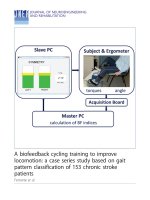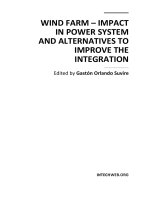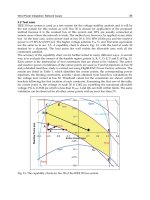blood lactate and training to improve threshold
Bạn đang xem bản rút gọn của tài liệu. Xem và tải ngay bản đầy đủ của tài liệu tại đây (32.81 KB, 3 trang )
Type II muscle fibers oxidize lactate at a very fast rates. When muscle
contraction produces a significant amount of lactate, it is then released
into the central circulation of the blood, and within seconds it is made
available to that muscle for energy. Therefore, 75% of the lactate
produced from high intensity exercise is made available for energy
production in type II muscle fibers. The remaining 25% of lactic acid is
used for energy in the heart, the make up of liver glycogen, and the
supply of energy to inactive muscles. A good example of this would be a
runner who is exceeding his or her planned race pace in a 10k. The
excess lactic acid accumulated in the contracting muscle from insufficient
oxygen is then made available to inactive muscles (e.g., the arms) from
the central circulation of blood.The remaining lactic acid that is not
directly oxidized for fuels is sent to the liver, where it is stored as
glycogen. In the process of exercise, glycogen is released into the blood
stream to form glucose.Lactate is GoodAs coach and athlete you must
learn how to teach the body to handle lactic acid. It is imperative, if you
want successes in today's highly competitive field of athletics to train your
muscles, body and mind to accomplish gains in performance even in the
presence of lactic acid. Coaches and athletes should design training
programs with this being a primary focus. This is done by two basic
components of training.Long Slow Distance (LSD) training beyond the
normal racing distance, will develop tissue enzyme adaptations that will
rely upon the use of free fatty acids for energy production, which will
result in less lactic acid being produced. LSD training will also increase
the rate of lactic acid removal from the blood and muscles. During
continuos steady state exercise, you increase capillary density and
mitochondria function in skeletal muscle, These two peripheral
adaptations brought on by LSD training will enable your body to handle
lactic acid much more efficiency. High intensity training will develop the
cardiovascular system to increase the rate of oxygen transport to the
contracting muscles so there is less reliance on carbohydrate breakdown
to lactic acid. High intensity training such as intervals., and variable pace
workouts, will increase your functional capacity (Max VO2). This means
that in actual competition you will produce less lactic acid, because your
muscles are relying mostly on the use of free fatty acids for fuel. The
lactic acid that is produce will be removed by the tissues that can use it as
fuel, such as the heart and type II muscle fibers.More On Aerobic Type
TrainingWhen it comes right down to it, the main way to increase oxygen
uptake is to do distance, plain and simple. Generally speaking, Type I
muscle fibers (the endurance fibers) are the fibers which must be trained
in order to raise VO2 Max, But, what exactly does raising VO2 Max entail
and what is happening.VO2 Max is comprised of several factors: VO2 =
Q X (A-Vo2 difference) where Q = Heart rate * volume of blood pumped
per beat and (A-Vo2 difference) is the amount of oxygen extracted by the
muscle. So, there are three things involved. Well, since, by definition
VO2 Max will be highest at maximum heart rate, it would be great if you
could raise this. Unfortunately, maximum heart rate is genetically
determined and does not change with training (although it does decrease
with age). One of the effects of prolonged endurance training is an
increase in heart size and pumping strength. These two factors see to
raise the volume of blood which can be pumped per beat. Incidentally,
this is also part of why aerobic athletes have very decreased resting heart
rates. Actually, their Q values are the same as sedentary people, it's just
that since their heart can pump more blood in a given beat, the heart
doesn't have to beat as often at rest.Well, another adaptation to
endurance exercise is an increase in aerobic enzymes in the muscles and
an increase in mitochondria density and number. This serves to increase
the (A-V02 difference) as the muscles are now capable of extracting more
oxygen from the blood. This increase generally occurs the most in the
Type I fibers which have the most aerobic enzymes and mitochondria to
begin with. Hence, in order to improve VO2 Max, it is necessary to both
stress the heart to improve stroke volume and also the Type I muscle
fibers to get the necessary enzymatic changes to occur. Basically, the
key to both of these is duration. Also, note that, in order to be competitive
in endurance events, you cannot do only distance work. Although much
of the race may be done at low intensities, there will be times (hills, final
sprints) when you need to go faster than your easy pace. If all you've
done is distance work, you'll get blown away during these times. That's'
why its imperative to include an anaerobic component to your training
(intervals) to compliment the aerobic conditioning to race successfully. AT
Training Anaerobic Threshold Conditioning works in two ways. The first
is an increase in maximal heart rate due to a rise in cardiac output and
stroke volume. The second is the specific training of Type IIa muscle
cells, which have some aerobic capacities, unlike Type IIb (which is also
a Fast Twitch muscle fiber, but has no aerobic capabilities). AT training
enhances aerobic enzyme activity and muscle density in the Type II cells,
giving them a greater ability to supply O2 for the energy you need when
racing at high speeds. The way to achieve these gains is through
intervals. Intervals are designed to bring heart rate, cardiac output and
02 intake to maximal values, which help you obtain those last little gains
in VO2 your economy. We all reach a point in our fitness where it is very
difficult to improve our performance even the slightest bit. Intervals will
work on your cardiovascular system, improving O2 delivery and efficiency
rates, giving you a boost in ability. More importantly, they will allow you to
exercise continually at a higher percentage of your functional capacity.AT
Training Can Improve Performance By 7-8%Researches have shown that
a trained endurance athlete can improve his or her performance by 7-8%
by including AT work in the weekly workout. A 7% increase in aerobic
capacity could mean a considerable time difference in a 10k
performance. For example, if you complete the 10k in 38 minutes, a 7%
increase in your aerobic capacity could allow you to better your best time
by a little over 2 minutes. The reason for this increase is that with AT
training you train your 02 system to work more efficiently. In order to
improve your oxygen delivery system adequately enough to get these
benefits it's necessary to perform anaerobic conditioning which, contrary
to popular belief, does not necessarily mean exercising without oxygen.
Anaerobic simply means that you can't supply enough 02 or energy to the
active muscles in order for them to constantly rely upon fat and glycogen
as their sole energy source. At high intensity exercise there is not
enough 02 provided. Thus you slip into anaerobic metabolism, which
involves the breakdown of glucose to pyruvic acid and lactate acid without
the presence of 02. This makes up the difference and supplies additional
energy to your muscles to keep them going. There are several different
types of AT training that one can do to enhance the oxygen delivery
system, including Long Fast Distance Variable Pace, Fartleks, and
Tempo runs.









